

Learn Multi platform 6309 Assembly Programming... With Secret stuff!
| The 6809 was pretty good... and
Hitachi decided they wanted to make their own version - the 6309! However, they decided they could do better, and added a ton of extra commands and registers to the chip!... the 6309 has an extra 2 eight bit registers, for a total of 32 bits! Rather strangely they forgot to tell anyone, and it was much later that anyone found out about all the extra functionality! |
Useful Resources
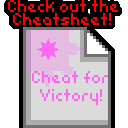 |
If
you
want to learn 6309 get the 6309
cheatsheet It contains all the 6809 and 6309 opcodes. |
 |
 |
We'll be using
Macroassembler AS for our assembly in these tutorials... VASM is
an assembler which supports rarer CPU's like 6309 and 65816 and
many more, and also supports multiple syntax schemes... You can get the source and documentation for AS from the official website HERE |
What is
the 6309 and what are 8 'bits' You can skip this if you
know about binary and Hex (This is a copy of the same section in the Z80
tutorial)
The 6309 is an 8-Bit processor with a 16 bit Address bus!... it has two 8 bit accumulators, A and B, that can be combined to make up one 16 bit accumulator D (AB)
What's 8 bit... well, one 'Bit' can be 1 or 0
four bits make a Nibble (0-15)
two nibbles (8 bits) make a byte (0-255)
two bytes (16 bits) make a word (0-65535)
And what is 65535? well that's 64 kilobytes ... in computers Kilo is 1024, because four bytes is 1024 bytes
64 kilobytes is the amount of memory a basic 8-bit system can access
the 6309 is 8 bit so it's best at numbers less than 256... it can do numbers up to 65535 too more slowly... and really big numbers will be much harder to do! - we can design our game round small numbers so these limits aren't a problem.
Numbers in Assembly can be represented in different ways.
A 'Nibble' (half a byte) can be represented as Binary (0000-1111) , Decimal (0-15) or Hexadecimal (0-F)... unfortunately, you'll need to learn all three for programming!
Also a letter can be a number... Capital 'A' is stored in the computer as number 65!
Think of Hexadecimal as being the number system invented by someone wit h 15 fingers, ABCDEF are just numbers above 9!
Decimal is just the same, it only has 1 and 0.
In this guide, Binary will shown with a % symbol... eg %11001100 ... hexadecimal will be shown with & eg.. &FF.
Another way to think of binary is think what each digit is 'Worth' ... each digit in a number has it's own value... lets take a look at %11001100 in detail and add up it's total
If a binary number is small, it may be shown as %11 ... this is the same as %00000011
Also notice in the chart above, each bit has a number, the bit on the far right is no 0, and the far left is 7... don't worry about it now, but you will need it one day!
But wait! I said a Byte could go from 0-255 before, well what happens if you add 1 to 255? Well it overflows, and goes back to 0!... The same happens if we add 2 to 254... if we add 2 to 255, we will end up with 1
this is actually usefull, as if we want to subtract a number, we can use this to work out what number to add to get the effect we want
The 6309 Registers
Compared to the 6502, the 6309 is seriously powerful - and even gives the Z80 something to think about!
The 6309 is an 8-Bit processor with a 16 bit Address bus!... it has two 8 bit accumulators, A and B, that can be combined to make up one 16 bit accumulator D (AB)
What's 8 bit... well, one 'Bit' can be 1 or 0
four bits make a Nibble (0-15)
two nibbles (8 bits) make a byte (0-255)
two bytes (16 bits) make a word (0-65535)
And what is 65535? well that's 64 kilobytes ... in computers Kilo is 1024, because four bytes is 1024 bytes
64 kilobytes is the amount of memory a basic 8-bit system can access
the 6309 is 8 bit so it's best at numbers less than 256... it can do numbers up to 65535 too more slowly... and really big numbers will be much harder to do! - we can design our game round small numbers so these limits aren't a problem.
 |
You probably
think 64 kilobytes doesn't sound much when a small game now
takes 8 gigabytes, but that's 'cos modern games are sloppy,
inefficient, fat and lazy - like the basement dwelling
losers who wrote them!!! 6309 code is small, fast, and super efficient - with ASM you can do things in 1k that will amaze you! |
Numbers in Assembly can be represented in different ways.
A 'Nibble' (half a byte) can be represented as Binary (0000-1111) , Decimal (0-15) or Hexadecimal (0-F)... unfortunately, you'll need to learn all three for programming!
Also a letter can be a number... Capital 'A' is stored in the computer as number 65!
Think of Hexadecimal as being the number system invented by someone wit h 15 fingers, ABCDEF are just numbers above 9!
Decimal is just the same, it only has 1 and 0.
In this guide, Binary will shown with a % symbol... eg %11001100 ... hexadecimal will be shown with & eg.. &FF.
| Assemblers will
use a symbol to denote a hexadecimal number, some use $FF or #FF
or even 0x, but this guide uses & - as this is how
hexadecimal is represented in CPC basic All the code in this tutorial is designed for compiling with WinApe's assembler - if you're using something else you may need to change a few things! But remember, whatever compiler you use, while the text based source code may need to be slightly different, the compiled "BYTES' will be the same! |
 |
| Decimal | 0 | 1 | 2 | 3 | 4 | 5 | 6 | 7 | 8 | 9 | 10 | 11 | 12 | 13 | 14 | 15 | ... | 255 |
| Binary | 0000 | 0001 | 0010 | 0011 | 0100 | 0101 | 0110 | 0111 | 1000 | 1001 | 1010 | 1011 | 1100 | 1101 | 1110 | 1111 | 11111111 | |
| Hexadecimal | 0 | 1 | 2 | 3 | 4 | 5 | 6 | 7 | 8 | 9 | A | B | C | D | E | F | FF |
Another way to think of binary is think what each digit is 'Worth' ... each digit in a number has it's own value... lets take a look at %11001100 in detail and add up it's total
| Bit position | 7 | 6 | 5 | 4 | 3 | 2 | 1 | 0 |
| Digit Value (D) | 128 | 64 | 32 | 16 | 8 | 4 | 2 | 1 |
| Our number (N) | 1 | 1 | 0 | 0 | 1 | 1 | 0 | 0 |
| D x N | 128 | 64 | 0 | 0 | 8 | 4 | 0 | 0 |
| 128+64+8+4= 204 So %11001100 = 204 ! | ||||||||
If a binary number is small, it may be shown as %11 ... this is the same as %00000011
Also notice in the chart above, each bit has a number, the bit on the far right is no 0, and the far left is 7... don't worry about it now, but you will need it one day!
| If you ever get confused, look at Windows
Calculator, Switch to 'Programmer Mode' and it has binary
and Hexadecimal view, so you can change numbers from one form to
another! If you're an Excel fan, Look up the functions DEC2BIN and DEC2HEX... Excel has all the commands to you need to convert one thing to the other! |
 |
But wait! I said a Byte could go from 0-255 before, well what happens if you add 1 to 255? Well it overflows, and goes back to 0!... The same happens if we add 2 to 254... if we add 2 to 255, we will end up with 1
this is actually usefull, as if we want to subtract a number, we can use this to work out what number to add to get the effect we want
| Negative number | -1 | -2 | -3 | -5 | -10 | -20 | -50 | -254 | -255 |
| Equivalent Byte value | 255 | 254 | 253 | 251 | 246 | 236 | 206 | 2 | 1 |
| Equivalent Hex Byte Value | FF | FE | FD | FB | F6 | EC | CE | 2 | 1 |
 |
All these number types can be confusing,
but don't worry! Your Assembler will do the work for you! You can type %11111111 , &FF , 255 or -1 ... but the assembler knows these are all the same thing! Type whatever you prefer in your ode and the assembler will work out what that means and put the right data in the compiled code! |
The 6309 Registers
Compared to the 6502, the 6309 is seriously powerful - and even gives the Z80 something to think about!
|
MD: 0I------FN
CC: EFHINZVC
|
||||||||||||||||||||||||||||||||||||||||||||||||||||||||||||||||||||||||||||||||||||||||||||||||||||||||||||||||||||||||||||||||||||||||||||||||||||
note E and F cannot be pushed with PSHS ...
you must use PSHSW and PULSW (W=E+F)
| The Direct page is like the 6502 Zero Page, however
it does not need to be at zero! We can load A with a value, then TFR A,DP to set the direct page... we need to tell the assembler where the direct page is, otherwise some commands may malfunction, we do this with ASSUME dpr:$xx - this is called SETDP on some assemblers |
 |
Like the 68000, the 6309 is BIG
ENDIAN... this means a 16 bit pair stored to an address like $6000
will save the high byte to $6000, and the low byte to $6001
Special Memory addresses on the 6309
Unlike the 6502, The 6309 has full 16 bit Stack pointers, U and S.... the 'Zero Page' (AKA Direct Page) can also be re positioned
Like the 6502, there are a variety of
'Interrupt Vectors' with fixed addresses...
| Address | Vector (Address) | Registers Auto-pushed onto stack |
| $FFF2 | SWi 3
Vector |
D,X,Y,U,DP,CC |
| $FFF4 | SWI 2
Vector |
D,X,Y,U,DP,CC |
| $FFF6 | FIRQ Vector | CC (E
flag cleared) |
| $FFF8 | IRQ Vector | D,X,Y,U,DP,CC |
| $FFFA | SWI 1 Vector | D,X,Y,U,DP,CC |
| $FFFC | NMI Vector | D,X,Y,U,DP,CC |
| $FFFE | RESET Vector | NA |
The 6309 Addressing Modes
The 6502 has 11 different addrssing modes... many have no comparable equivalent on the Z80
| Inherent Addressing | Commands that don't take a parameter | ABX |
| Register Addressing | Commands that only use register | TFR A,DP |
| Immediate Addressing | Direct Address of command | ADDA #$10 ADDD #$1000 |
| Direct Page addressing | Read from DP (zero page) | ADDA $10 |
| Extended Direct addressing | Read from an address | ADDA $1234 |
| Extended Indirect Addressing | Read from the address specified... then get the value from that address | ADDA [$1234] |
| Indexed Addressing | Uses a 2nd setting byte - allows for Autoinc | ,R offset,R label,pcr ,R+ ,-R [] |
| Indexed Addressing: Zero Offset | Just use the address in the register | LDA ,Y LDA 0,Y LDA Y |
| Indexed Addressing: 5 bit offset | -16 to +15 offset | LDA -1,Y |
| Indexed Addressing: Constant offset from base register | 8 / 16 bit offset from X,Y,U,S ... Can be negative or positive | LDA 1000,Y |
| Indexed Addressing: Constant Offset From PC | 8 / 16 bit offset from PC | LDA $10,PC |
| Program counter relative | PCR is like PC, but is calculated by the assembler | ADDA label,PCR |
| Indirect with constant offset from base register | Load from the address in the register + offset | LDA [1,X] |
| Accumulator offset from Base register | Add accumulator (A/B/D) to a X,Y,U,S (not PC) | LDA B,Y |
| Indirect Accumulator offset from Base register | Load from the address made up of a X,Y,U,S Plus the accumulator | LD [B,Y] |
| AutoIncrement | Add 1 or 2 to the register | ADDA ,X+ ADDA ,X++ |
| AutoDecrement | Subtract 1 or 2 from the register | ADDA ,-X ADDA ,--X |
| Indirect AutoIncrement | Load from the address in Register, then add 1 or 2 | ADDA [,X+] ADDA [,X++] |
| Indirect AutoDecrement | Subtract 1 or 2 then Load from the address in Register | ADDA [,-X] ADDA [,--X] |
| Program relative | Offset to PC | BRA label |
Hints
Saving a byte on return:
Rather than returning, if your last command is a pop, just pop the PC with your other registers:
PULS B , X , PC
Addresses, Numbers and Hex... 6309 notification
We'll be using VASM for our assembler, but most other 6502 assemblers use the same formats... however coming from Z80, they can be a little confusing, so lets make it clear which is which!
| Prefix | Example | Z80 equivalent | Meaning |
| # | #16384 | 16384 | Decimal Number |
| #% | #%00001111 | %00001111 | Binary Number |
| #$ | #$4000 | &4000 | Hexadecimal number |
| #' | #'a | 'a' | ascii value |
| 12345 | (16384) | decimal memory address | |
| $ | $4000 | (&4000) | Hexadecimal memory address |
Missing Commands!
Commands we don't have, but might want!
Commands we don't have, but might want!
| DEX/DEY/INX/INY | Tfr X,D ;replace X with Y if required DecB ;or IncB as required Tfr D,X ;replace X with Y if required |
|
| CLC | AndCC #%11111110 | |
| SEC | OrCC #%00000001 | |
| DeX |
LEAX -1,X |
|
| Lesson
1 - Getting started with 6309 Lets learn the basics of using 6309... We'll take a look at the new registers, and some of the new commands. |
 The 6809 devtools support 6309 |
6309_Lesson_1.asm
|
 |
 |
6309 supports
everything 6809 does... so we'll only cover the new stuff here! If you don't know 6809 yet, please see these tutorials! |
New Registers!
| The 6809's two 8 bit registers have been doubled! As well as the old A and B, we now have E and F! |
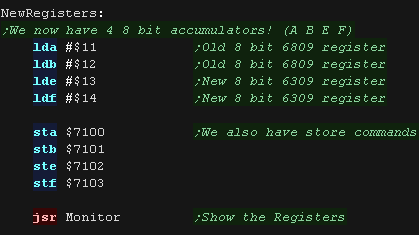 |
| Of course, The 16 bit D register is still made up of A+B, but we
now have another 16 bit pair known as W W is made up of E+F |
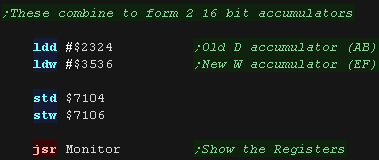 |
| All 4 8 bit registers are combined in some cases to make one 32
bit quad, known as Q Q is made up of A+B+E+F |
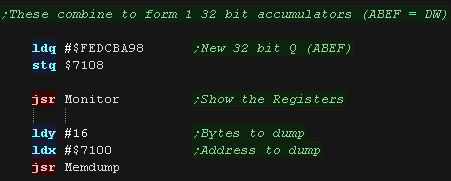 |
| There are a few more weird and wonderful registers! 0 (or z in asw) is a hardwired zero, we can use it as a substitute for a regsiter, to get a zero value, or 'discard' the result of a command. V is a 16 bit register referred to as the 'Transfer Value'. We can't set it directly like E and F, but we can move values into it. Also, strangely, it keeps its value after a reboot! The final register is MD - the MoDe register. We can turn on bit 0 to enable Native 6309 mode, though we can use all the new commands without doing so!. Turning on native mode alters the way the interrupts work. |
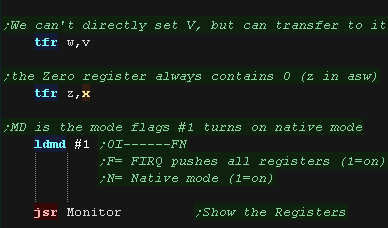 |
| Here are the results. |
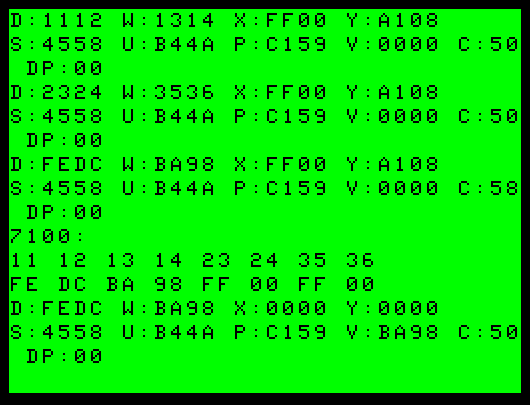 |
| Commands using the
new registers like E and F often take an extra byte than the
ones using A and B. You should still prioritize the original registers where you can, and just use the new ones as an alternative to the zero page, or to reduce push pops. |
 |
| Many of the previous maths commands can now be used with the new
registers. We can use Clear, Inc and Dec... and these now even work with the D register. The new registers also work with ADD and SUB |
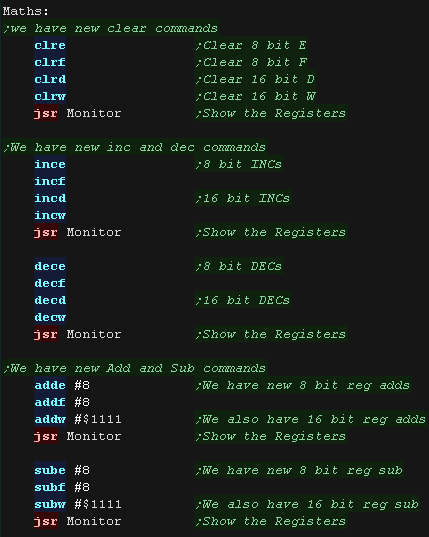 |
| Here are the results. |
 |
| We have new ADDR and SUBR commands, which will add and subtract
one register from/to another. The destination is on the right. ADCR and SBCR provide similar functions, but add and subtract the carry as well Unfortunately we dont have a 32 bit add or subtract command which works with Q, but we can use the 16 bit commands to effect a 32 bit add or subtract via the carry. |
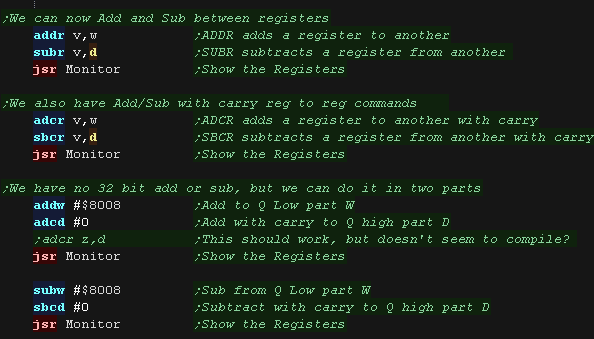 |
| Here are the results |
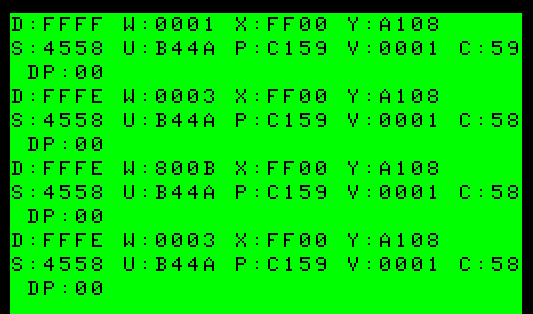 |
Rotation and shifts
| We now have 16 bit rotate
and shift commands, which work with the D and W registers. ROR and ROL shift between the 16 bits of the register, plus the carry as a 17th bit We do not, however, have any that work with the 32 bit Q |
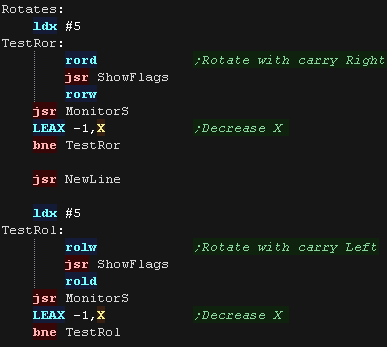 |
| Here are the results |
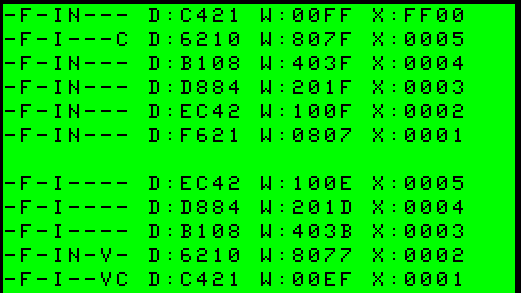 |
| We have new logical shift commands for unsigned 16 bit numbers. We now have LSRD and LSRW Strangely, while we have a LSLD, we do not have a LSLW, however "ADDR W,W" will add W to itself giving the same effect. |
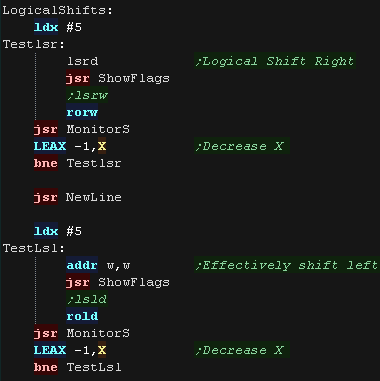 |
| Here are the results |
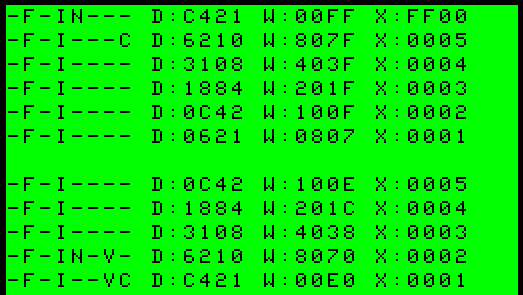 |
| We have new Arithmetic shift commands for signed 16 bit numbers. We now have ASRD and ASRW Strangely, while we have a ASLD, we do not have a ASLW, however "ADDR W,W" will add W to itself giving the same effect. |
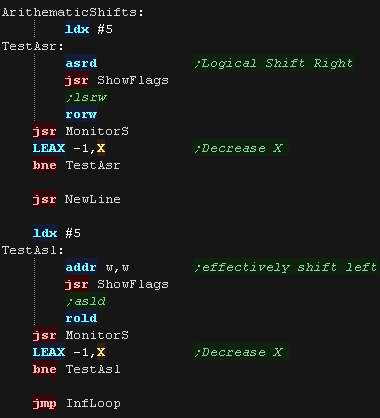 |
| Here are the results |
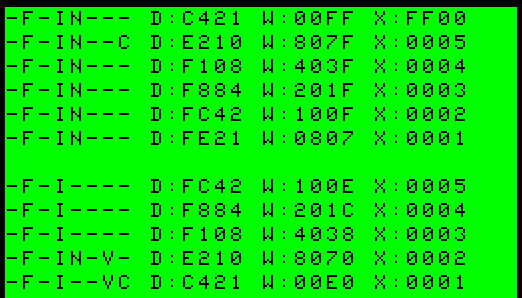 |
Tests and compares
| We have TST and CMP commands for the new 8 and 16 bit registers.
These commands work the same as usual. TST will set the Zero and Negative flags based on the contents of a register. CMP will set the flags like a subtraction, but will not change the tested register. Unfortunately these commands cannot work with the 32 bit Q register. |
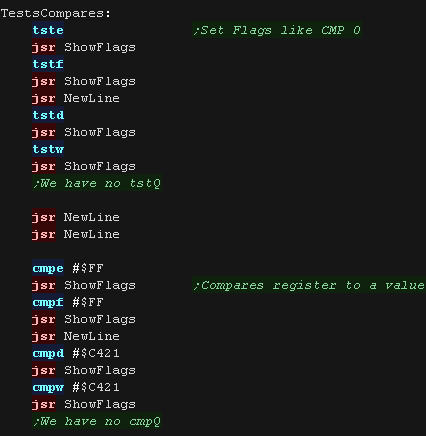 |
| Here are the results |  |
Logical Operations
| We have some new logical operations! EOR, AND and OR now can work with the 16 bit D register (but not the W one) We now also have commands which work with register to register values. The first specified register will be processed with the second, and the result stored in the second register. |
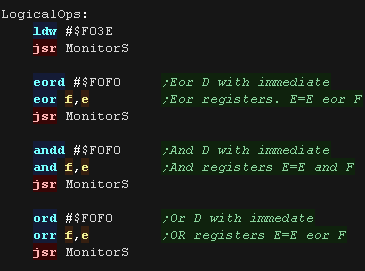 |
| Here are the results |
 |
| We have some new commands which perform an operation with an
Immediate value and the address in a register + an offset,
changing the byte at the effective address. EIM will Eor an Immediate with Memory AIM will And an Immediate with Memory OIM will Or an Immediate with Memory TIM will Test an Immediate with Memory - setting the flags like logical operation AND |
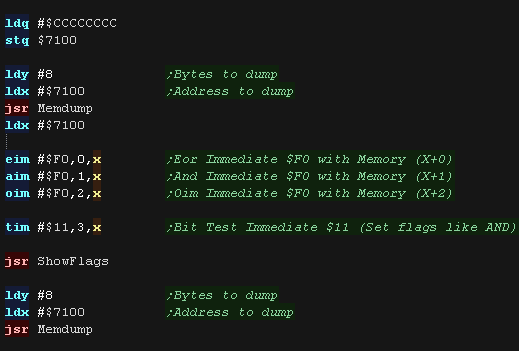 |
| Here are the results. |
 |
More Maths Operations
| We have a few other useful commands which perform Bit operations SEXW will Sign EXtend 16 bit W into a 32 bit value Q (effectively filling D with the top bit of W) NEGD will negate the 16 bit D register - however there is no command to negate the W register. We also have a COMplement command, which will flip the bits of a register, this works on all the 8 and 16 bit registers, but the 32 bit Q cannot be flipped in a single command |
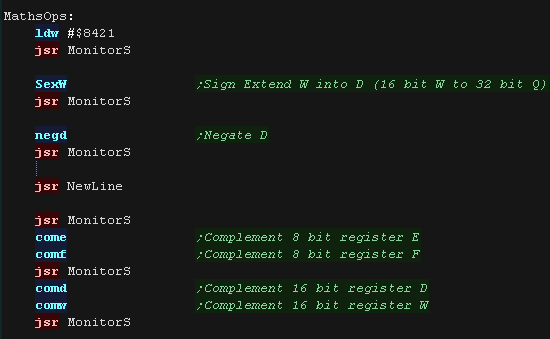 |
| Here are the results |
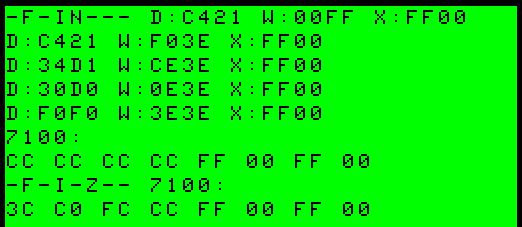 |
| Lesson
3 - More new commands! Lets take a look at the last of the new 6309 commands. |
 The 6809 devtools support 6309 |
6309_Lesson_3.asm
|
 |
Push and Pull Commands
| The PSH and PUL commands do
not work with the new E and F registers (and by implication W) The only way to backup and restore these registers via the stack are using the 4 new commands. PSHSW will Push W onto the S stack. PULSW will Pull W off the S stack. PSHUW will Push W onto the U stack. PULUW will Pull W off the U stack. |
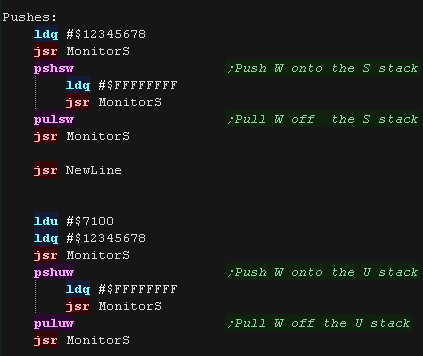 |
| Here are the results |
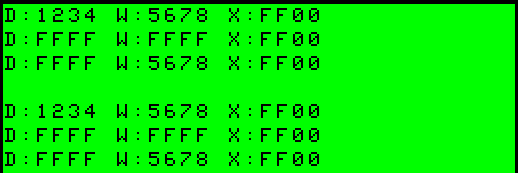 |
Bulk transfer commands
| The 6309 adds some impressive new bulk transfer commands...
these give functions like LDIR on the Z80, or MVN on the 65816. The TFM command allows us to transfer from one register to another, with a variety of Increment and Decrement options (4 in total) TFM r1+,r2+ will copy W bytes from the address in r1 to the address in r2, incrementing both after each byte. TFM r1-,r2- will copy W bytes from the address in r1 to the address in r2, decrementing both after each byte. |
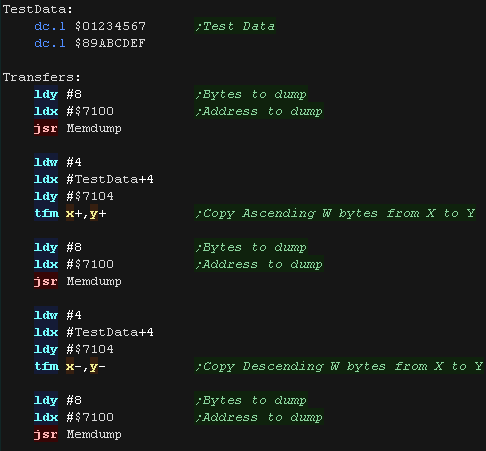 |
| Here are the results! We copied 4 bytes to the right, then 4 bytes to the left. |
 |
| We have two more slightly strange options TFM r1+,r2 will copy W bytes from the address in r1 to the address in r2, incrementing only the source after each byte TFM r1,r2+ will copy W bytes from the address in r1 to the address in r2, incrementing only the destination after each byte These could be usedful for transferring a block of data to, or from, a memory mapped hardware port. |
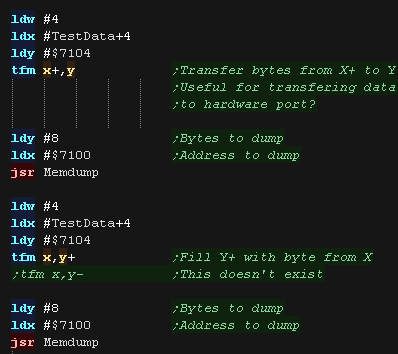 |
| Here are the results, first we transferred 89,AB,CD,EF to $7104
(leaving only EF visible) Then we transferred 89 four times. |
 |
Multiplication and Division
| We have a new 16/32 bit
Multiply command! MULD will multiply D by either an immediate or memory value - alas we can't multiply by the w register. DIVQ is the opposite, this divides the 32 bit value in Q by the specified value, putting the whole number result in W, and the remainder in D DIVD is the opposite of the original MUL command, this divides the 16 bit value in D, putting the whole number result in B and the remainder in A |
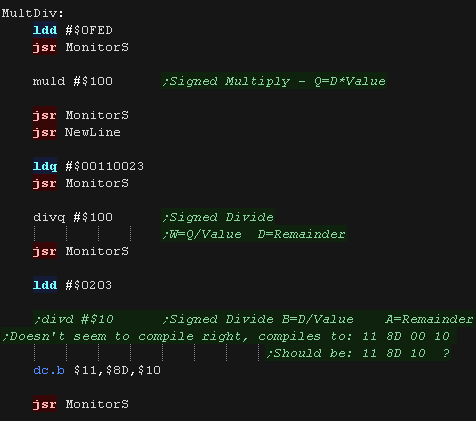 |
| Here is the results! |  |
| ASW seems to not assembly the DIVD command
correctly, it seems to store the immediate value as a 16 bit
value, causing the command to end up as 4 bytes, rather than the
apparently correct 3. |
 |
Bit Test and Set
| There are a set of special new commands for bit manipulation on
the 6309: LDBT Load Memory Bit into Register Bit STBT Store value of a Register Bit into Memory BAND Logically AND Register Bit with Memory Bit BOR Logically OR Memory Bit with Register Bit BEOR Exclusive-OR Register Bit with Memory Bit BITD Bit Test Accumulator D with Memory Word Value BIEOR Exclusively-OR Register Bit with Inverted Memory Bit BIOR Logically OR Register Bit with Inverted Memory Bit These have an odd format: CMD Reg.Bit, Address.Bit Where Reg and Address are the source/destination (Depending on the command), and Bit is the source and destination bit numbers (0-7) Unfortunately, it seems they are not emulated properly - the 3 register options A,B,CC are mixed up (I think the assembler is doing them right), so we won't be covering them in detail here. |
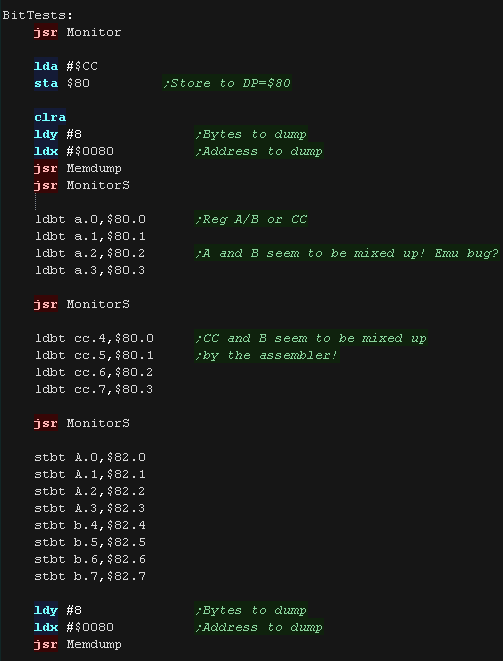 |
| View Options |
| Default Dark |
| Simple (Hide this menu) |
| Print Mode (white background) |
| Top Menu |
| ***Main Menu*** |
| Youtube channel |
| Patreon |
| Introduction to Assembly (Basics for absolute beginners) |
| Amazon Affiliate Link |
| AkuSprite Editor |
| ChibiTracker |
| Dec/Bin/Hex/Oct/Ascii Table |
| Alt Tech |
| Archive.org |
| Bitchute |
| Odysee |
| Rumble |
| DailyMotion |
| Please note: I wlll upload more content to these alt platforms based on the views they bring in |
| 68000 Content |
| ***68000 Tutorial List*** |
| Learn 68000 Assembly |
| Hello World Series |
| Platform Specific Series |
| Simple Samples |
| Grime 68000 |
| 68000 Downloads |
| 68000 Cheatsheet |
| Sources.7z |
| DevTools kit |
| 68000 Platforms |
| Amiga 500 |
| Atari ST |
| Neo Geo |
| Sega Genesis / Mega Drive |
| Sinclair QL |
| X68000 (Sharp x68k) |
| 8086 Content |
| Learn 8086 Assembly |
| Platform Specific Series |
| Hello World Series |
| Simple Samples |
| 8086 Downloads |
| 8086 Cheatsheet |
| Sources.7z |
| DevTools kit |
| 8086 Platforms |
| Wonderswan |
| MsDos |
| ARM Content |
| Learn ARM Assembly |
| Learn ARM Thumb Assembly |
| Platform Specific Series |
| Hello World |
| Simple Samples |
| ARM Downloads |
| ARM Cheatsheet |
| Sources.7z |
| DevTools kit |
| ARM Platforms |
| Gameboy Advance |
| Nintendo DS |
| Risc Os |
| Risc-V Content |
| Learn Risc-V Assembly |
| Risc-V Downloads |
| Risc-V Cheatsheet |
| Sources.7z |
| DevTools kit |
| MIPS Content |
| Learn Risc-V Assembly |
| Platform Specific Series |
| Hello World |
| Simple Samples |
| MIPS Downloads |
| MIPS Cheatsheet |
| Sources.7z |
| DevTools kit |
| MIPS Platforms |
| Playstation |
| N64 |
| PDP-11 Content |
| Learn PDP-11 Assembly |
| Platform Specific Series |
| Simple Samples |
| PDP-11 Downloads |
| PDP-11 Cheatsheet |
| Sources.7z |
| DevTools kit |
| PDP-11 Platforms |
| PDP-11 |
| UKNC |
| TMS9900 Content |
| Learn TMS9900 Assembly |
| Platform Specific Series |
| Hello World |
| TMS9900 Downloads |
| TMS9900 Cheatsheet |
| Sources.7z |
| DevTools kit |
| TMS9900 Platforms |
| Ti 99 |
| 6809 Content |
| Learn 6809 Assembly |
| Learn 6309 Assembly |
| Platform Specific Series |
| Hello World Series |
| Simple Samples |
| 6809 Downloads |
| 6809/6309 Cheatsheet |
| Sources.7z |
| DevTools kit |
| 6809 Platforms |
| Dragon 32/Tandy Coco |
| Fujitsu FM7 |
| TRS-80 Coco 3 |
| Vectrex |
| 65816 Content |
| Learn 65816 Assembly |
| Hello World |
| Simple Samples |
| 65816 Downloads |
| 65816 Cheatsheet |
| Sources.7z |
| DevTools kit |
| 65816 Platforms |
| SNES |
| eZ80 Content |
| Learn eZ80 Assembly |
| Platform Specific Series |
| eZ80 Downloads |
| eZ80 Cheatsheet |
| Sources.7z |
| DevTools kit |
| eZ80 Platforms |
| Ti84 PCE |
| IBM370 Content |
| Learn IBM370 Assembly |
| Simple Samples |
| IBM370 Downloads |
| IBM370 Cheatsheet |
| Sources.7z |
| DevTools kit |
| Super-H Content |
| Learn SH2 Assembly |
| Hello World Series |
| Simple Samples |
| SH2 Downloads |
| SH2 Cheatsheet |
| Sources.7z |
| DevTools kit |
| SH2 Platforms |
| 32x |
| Saturn |
| PowerPC Content |
| Learn PowerPC Assembly |
| Hello World Series |
| Simple Samples |
| PowerPC Downloads |
| PowerPC Cheatsheet |
| Sources.7z |
| DevTools kit |
| PowerPC Platforms |
| Gamecube |
| Work in Progress |
| ChibiAndroids |
| Misc bits |
| Ruby programming |
Buy my Assembly programming book
on Amazon in Print or Kindle!



Available worldwide!
Search 'ChibiAkumas' on
your local Amazon website!
Click here for more info!


Buy my Assembly programming book
on Amazon in Print or Kindle!



Available worldwide!
Search 'ChibiAkumas' on
your local Amazon website!
Click here for more info!


Buy my Assembly programming book
on Amazon in Print or Kindle!



Available worldwide!
Search 'ChibiAkumas' on
your local Amazon website!
Click here for more info!



